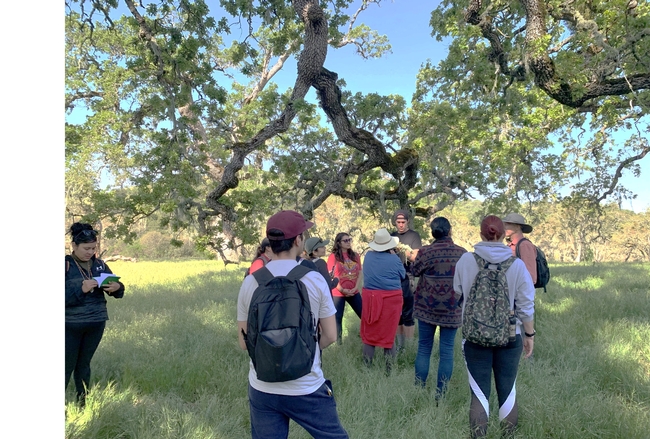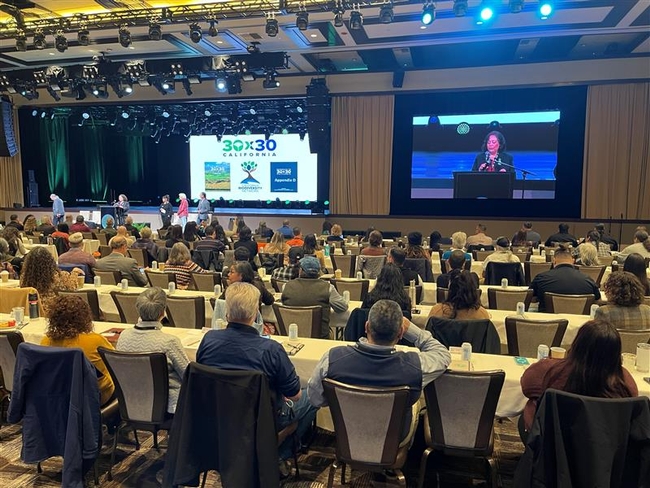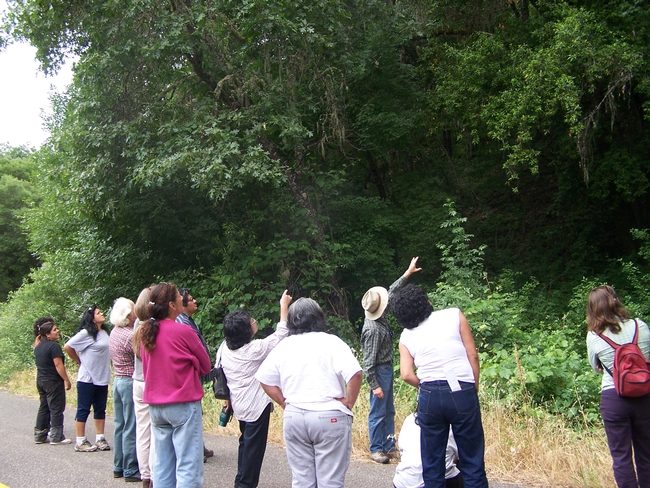Posts Tagged: Tribes
Lawn-pocalypse! Surviving Drought
Ah, summer! The season of sunburns, pool parties, and… lawn droughts. If your once lush, green carpet now looks like a crunchy brown doormat, you're not alone. Let's dive into why your yard is staging a dramatic death scene and what you can do to...

Bermuda grass and weeds overtaking drought stressed turf grass.
Exploring the why, what and hope in LandBack
The Berkeley City Council recently agreed to purchase a two-acre site (currently used for parking) known as the shellmound and a place of sacred ceremonies and turn over it over to the Sogorea Te' Land Trust, which is planning to restore the site to a place of gathering and ceremonies. This is an example of LandBack.
LandBack is a growing movement focused on returning land to Indigenous people, encompassing various actions to enhance their access to and stewardship of ancestral homelands. To fully grasp the movement's importance, one must understand the history of U.S. law, as rooted in the colonial Doctrine of Discovery, dating back to the late 15th century. This legal and theological concept was rooted in the idea that Christian European nations had the right to claim and control lands that were inhabited by non-Christians to justify European exploration, colonization and the dispossession of Indigenous peoples who were relegated to a non-human status. This worldview facilitated the colonization of new lands and the enslavement of Native people for extracting resources like minerals, animal pelts, forests, range and agricultural production.
The U.S. courts persist in upholding the belief that the U.S. government holds the ultimate right to own and control the land, regardless of the presence and claims of Indigenous peoples. This perpetuation leads to ongoing land dispossession and creates enduring barriers to land access, impeding Indigenous stewardship. Consequently, Native communities experience adverse effects on their well-being, cultural vitality and intergenerational knowledge transfer. LandBack is crucial for Indigenous people to steward the land in a manner that restores their reciprocal relationships dating back to time immemorial.
Some recent policies help enable the principles of LandBack. For example, California law (SB-18, 2004) recognizes tribes' ability to hold conservation easements on land in order to protect cultural resources, enable access and engage in stewardship; and requires state agencies to have tribal consultation policies. The Native American Ancestral Lands Policy (2020) facilitates tribal access, use and co-management of state-owned or controlled natural lands. Goals include prioritizing tribal purchase or transfer of excess land, establishing co-management agreements and providing grants for land procurement and conservation.
The LandBack movement is gaining momentum to address justice, promote Indigenous stewardship, protect the community of life and advance climate resilience thanks to tribal leadership and collaborations with a variety of entities, including individuals, religious institutions, land trusts, and local, state and national governments. Actions range from the full return of land without restriction to more limited agreements including enabling co-stewardship of land, especially on public lands such as federal or state parks, forests, and wildlife refuges.
UC's Tribal Lands Workgroup
Through leadership from the UC Office of President, a systemwide Tribal Lands Workgroup is focusing on the following topics. Members of the workgroup, with assistance from UCANR's Informatics and Geographic Information System, assembled a mapped inventory of UC lands as well as tribal territory and other land cover information. The workgroup has also researched existing systemwide memoranda of understanding or other agreements with tribes related to the use of UC land.
A good example is the memorandum of understanding developed between the UC Hopland Research and Extension Center, which is part of UCANR, and Hopland Band of Pomo Indians (HBPI) who manage neighboring lands. This agreement is designed to increase the educational, research, land stewardship and cultural exchange opportunities between HBPI and UCANR, and delineate areas where we can work together on specific projects. Given the interest in creating these types of collaborative opportunities, this agreement is likely just the first of more to come. This UC workgroup is also exploring the best way to develop and share guidelines for engaging with tribes about use of UC land consistent with tribal consultation processes and existing rules and regulations.
Co-stewardship Workshop
To learn from existing co-stewardship models, several UC scientists including myself, Steve Monfort, director of UC Natural Reserves; and Patrick Gonzalez, executive director of UC Berkeley Institute for Parks, People and Biodiversity; worked with other California Biodiversity Council steering committee members and in partnership with the Federated Indians of Graton Rancheria and with consultation from the Native American Research Institute to organize a workshop titled “Indigenous Co-stewardship of Public Lands: Lessons for the Future.” Funding was provided by the Gordon & Betty Moore Foundation, Resources Legacy Fund and Federated Indians of Graton Rancheria.
This workshop held in February 2024 was well-attended by tribal leaders, Indigenous culture bearers and staff from public land-management agencies, with a total of 536 registered for the livestream and approximately 300 in person.
Chairman Greg Sarris of Federated Indians of Graton Rancheria provided important context, examples of co-stewardship in action from Sonoma County and inspiration to do more. Samuel Kohn, senior counselor to Office of the Assistant Secretary of Indian Affairs, explained the various federal policies and guidelines that relate to co-management with tribes. The heart of the workshop was a series of co-stewardship case studies from California, other states and Canada. These were followed by examples of Indigenous people in Mexico engaging in stewardship and sustaining their livelihoods. A real snapshot of the topic across North America!
We spent the second day together visiting places now known as Point Reyes National Seashore and Tolay Lake Regional Park that have long-term co-management agreements initiated by Federated Indians of Graton Rancheria. A more thorough summary of the workshop can be found at News from Native California by Tavi Lorelle Carpenter.
If you are interested in working with tribes and tribal communities, please join the UC ANR Native American Community Partnerships Workgroup. Contact co-chairs Jennifer Sowerwine at jsowerwi@berkeley.edu and Christopher J. McDonald at cjmcdonald@ucanr.edu.
Climate-Change Resources
University of California UC ANR Green Blog (Climate Change and Other Topics) https://ucanr.edu/blogs/Green/index.cfm?tagname=climate%20change (full index)
Examples:
- Save Trees First: Tips to Keep Them Alive Under Drought https://ucanr.edu/b/~CdD
- Landscaping with Fire Exposure in Mind: https://ucanr.edu/b/~G4D
- Cities in California Inland Areas Must Make Street Tree Changes to adapt to Future Climate https://ucanr.edu/b/~oF7
Drought, Climate Change and California Water Management Ted Grantham, UC Cooperative Extension specialist (23 minutes) https://youtu.be/dlimj75Wn9Q
Climate Variability and Change: Trends and Impacts on CA Agriculture Tapan Pathak, UC Cooperative Extension specialist (24 minutes) https://youtu.be/bIHI0yqqQJc
California Institute for Water Resources (links to blogs, talks, podcasts, water experts, etc.) https://ciwr.ucanr.edu/California_Drought_Expertise/
UC ANR Wildfire Resources (publications, videos, etc.) https://ucanr.edu/News/For_the_media/Press_kits/Wildfire/ (main website)
-UC ANR Fire Resources and Information https://ucanr.edu/sites/fire/ (main website)
-Preparing Home Landscaping https://ucanr.edu/sites/fire/Prepare/Landscaping/
UC ANR Free Publications https://anrcatalog.ucanr.edu/ (main website)
- Benefits of Plants to Humans and Urban Ecosystems: https://anrcatalog.ucanr.edu/pdf/8726.pdf
-Keeping Plants Alive Under Drought and Water Restrictions (English version) https://anrcatalog.ucanr.edu/pdf/8553.pdf
(Spanish version) https://anrcatalog.ucanr.edu/pdf/8628.pdf
- Use of Graywater in Urban Landscapes https://anrcatalog.ucanr.edu/pdf/8536.pdf
- Sustainable Landscaping in California https://anrcatalog.ucanr.edu/pdf/8504.pdf
Other (Non-UC) Climate Change Resources
Urban Forests and Climate Change. Urban forests play an important role in climate change mitigation and adaptation. Active stewardship of a community's forestry assets can strengthen local resilience to climate change while creating more sustainable and desirable places to live. https://www.fs.usda.gov/ccrc/topics/urban-forests
Examining the Viability of Planting Trees to Mitigate Climate Change (plausible at the forest level) https://climate.nasa.gov/news/2927/examining-the-viability-of-planting-trees-to-help-mitigate-climate-change/
Reports and other information resources coordinated under the auspices of the United Nations and produced through the collaboration of thousands of international scientists to provide a clear and up to date view of the current state of scientific knowledge relevant to climate change. United Nations Climate Action
Scientific reports, programs, action movements and events related to climate change. National Center for Atmospheric Research (National Science Foundation)
Find useful reports, program information and other documents resulting from federally funded research and development into the behavior of the atmosphere and related physical, biological and social systems. Search and find climate data from prehistory through to an hour ago in the world's largest climate data archive. (Formerly the "Climatic Data Center") National Centers for Environmental Information (NOAA)
Think tank providing information, analysis, policy and solution development for addressing climate change and energy issues (formerly known as the: "Pew Center on Global Climate Change"). Center for Climate & Energy Solutions (C2ES)
Mapping Resilience: A Blueprint for Thriving in the Face of Climate Disaster. The Climate Adaptation Knowledge Exchange (CAKE) was launched in July 2010 and is managed by EcoAdapt, a non-profit with a singular mission: to create a robust future in the face of climate change by bringing together diverse players to reshape planning and management in response to rapid climate change. https://www.cakex.org/documents/mapping-resilience-blueprint-thriving-face-climate-disaster
Cal-Adapt provides a way to explore peer-reviewed data that portrays how climate change might affect California at the state and local level. We make this data available through downloads, visualizations, and the Cal-Adapt API for your research, outreach, and adaptation planning needs. Cal-Adapt is a collaboration between state agency funding programs, university and private sector researchers https://cal-adapt.org/
Find reports, maps, data and other resources produced through a confederation of the research arms of 13 Federal departments and agencies that carry out research and develop and maintain capabilities that support the Nation's response to global change. Global Change (U.S. Global Change Research Program)
The Pacific Institute is a global water think tank that combines science-based thought leadership with active outreach to influence local, national, and international efforts to develop sustainable water policies. https://pacinst.org/our-approach/
Making equity real in climate adaptation and community resilience policies and programs: a guidebook. https://greenlining.org/publications/2019/making-equity-real-in-climate-adaption-and-community-resilience-policies-and-programs-a-guidebook/
Quarterly CA Climate Updates and CA Drought Monitor Maps (updated each Thursday) https://www.drought.gov/documents/quarterly-climate-impacts-and-outlook-western-region-june-2022
Tribal Engagement at the Hopland Research and Extension Center
The Hopland Research and Extension Center is situated on the traditional, ancestral and unceded lands of the Shóqowa and Hopland People, whose historical and spiritual relationship with these lands continues to this day and beyond (for more on the Land and people history of the site, see this story map). It was, and continues to be, difficult for Indigenous people to thrive in the Shanél Valley after they were forced off the fertile land and had to resettle on relatively small upland parcels and away from freshwater sources. UC ANR staff and academics at the Hopland Research and Extension Center are working to build relationships with the Hopland Band of Pomo Indians who live and work next door at the Hopland and Nacomis Rancherias.
Hopland REC Director John Bailey is committed to building relationships with the intention of enabling maximum benefits for local tribal communities. Tribal Chairperson Sonny Elliot and the Council have been helping us find ways to collaborate after a long history of distrust and despite the University's founding using the sales of expropriated lands (Land-Grant College Act, 1862) and our continued occupation of California Indian territories. Bailey is working with local tribes to define a newly funded Academic Advisor position to build relationships, advance UC policy around working with Tribes, and restore good fire to the landscape with the help of cultural practitioners.
We have secured funding to hire a Native college student to help revitalize ecocultural wetlands in Hopland this summer. The intern will spend time talking with Indigenous people living within the oak woodland landscape or North Coast California and develop a plan for stewarding ecoculturally important sites at the Hopland Research and Extension Center with the Hopland Band of Pomo Indians and local experts in traditional ecological knowledge. This internship offers an opportunity for a Native American college student or two to learn about wetland systems and traditional ecological knowledge; and share their experience with other tribal community members.
Hunting opportunities for Tribal youth and their families and plant collection sites for basket materials are available. The hope is that more cultural ceremonies can take place where generations of Pomo people spent time near the waterways that span Hopland REC. Finally, together we are exploring ways to modify access of existing roads at Hopland REC to allow for potential emergency evacuation for Rancheria residents.
More to come, we hope.
Drought focus of Water Resources IMPACT magazine special issue
UC ANR experts address emotional toll of drought
Preparing the American West for prolonged drought is the focus of a double issue of Water Resources IMPACT magazine. The California Water Commission staff are guest editors for this special open-access edition of the magazine, which is published by the American Water Resources Association.
Faith Kearns, academic coordinator of University of California Agriculture and Natural Resources' California Institute for Water Resources, is among the authors delving into how drought impacts people and the environment and how we can better prepare for the inevitable.
The first issue, published on Feb. 14, focuses on water scarcity issues confronting California and the ways these issues affect different sectors.
In “Trauma, Care, and Solidarity: Addressing the Emotional Toll of Chronic Drought,” Kearns highlights the effects of drought on mental health. She points to the spike in suicide hotline calls when wells ran dry in Southeast Asian communities in California's Central Valley.
By listening to Southeast Asian farmers, Ruth Dahlquist-Willard and Michael Yang of UC Cooperative Extension were able to “lighten the load” for them by providing pragmatic support, Kearns writes.
“The scale of some of these highly emotional issues – drought, wildfires, climate change – can make them seem incredibly difficult, if not impossible, to deal with,” Kearns said. “At the same time, they are affecting everyone living in the western U.S. on a daily basis. I wanted to highlight and provide models based on work that people – whether they are researchers, clinical psychologists, or Cooperative Extension advisors – are doing right now to ease the way.”
The authors who contributed to the double issue are a diverse array of Tribal experts, academics, nongovernmental organization thought-leaders, water managers and water policy influencers, each of whom brings their own perspective on the topic of drought. Their expertise and perspectives in climate science, water policy and water management will help inform drought-related decision-making and support policies that better prepare the state to thrive during periods of prolonged water scarcity.
In addition to Kearns, the first issue includes articles contributed by:
- Samantha Stevenson, University of California, Santa Barbara
- Jay Lund, University of California, Davis
- Ron Goode, North Fork Mono Tribe
- Andy Fecko, Placer County Water Agency
- Jeff Mount, Public Policy Institute of California, and Ted Grantham, University of California, Berkeley/UC Cooperative Extension
- Nat Seavy and Karyn Stockdale, National Audubon Society
- Kjia Rivers, Community Water Center
- Cannon Michael, Bowles Farming
- Michelle Reimers, Turlock Irrigation District
The January/February edition of Water Resources IMPACT magazine can be accessed, free of charge, on the American Water Resources Association website at https://www.awra.org under “Publications.”
The second issue, to be published in March, will focus on drought response, considering the options for adaptation. This two-part series complements the Commission's work on strategies to protect communities and fish and wildlife in the event of a long-term drought.






